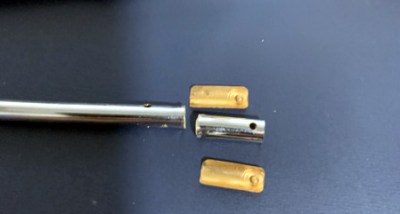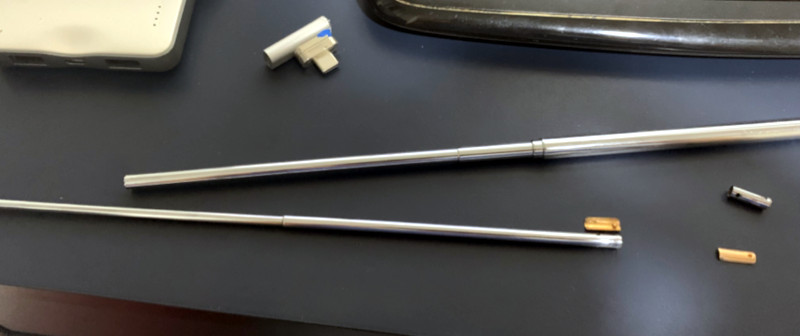Whether it was as an impulsive youth or an impatient adult, there’s probably few among us who haven’t broken a telescopic antenna or two over the years. It doesn’t take much to put a bend in the thin walled tubing, and after that, all bets are off. So [The Amateur Engineer] couldn’t really be too upset when his son snapped the antenna off the transmitter of an old RC truck. Instead, he decided to take it apart and see how it could be repaired.
 Taking a thin screwdriver to the antenna’s bottom most segment, he was able to widen up the opening enough to remove the upper sections as well as recover the broken piece and copper locking plates. He cut out the damaged area and drilled new holes for the pins on the copper plates to fit into. Inserting the repaired section back into the lowest segment was no problem, but he says it took a little trial and error before he was able to roll the edge over enough to keep the antenna from falling apart.
Taking a thin screwdriver to the antenna’s bottom most segment, he was able to widen up the opening enough to remove the upper sections as well as recover the broken piece and copper locking plates. He cut out the damaged area and drilled new holes for the pins on the copper plates to fit into. Inserting the repaired section back into the lowest segment was no problem, but he says it took a little trial and error before he was able to roll the edge over enough to keep the antenna from falling apart.
Buying a replacement would certainly have been easier, but as the radios in our devices have moved into the higher frequencies, these collapsible antennas have become a bit harder to come by. Modern RC vehicles operate on 2.4 GHz, so they don’t need the long antennas that the older 27 MHz systems utilized. [The Amateur Engineer] did find a few direct replacements online, but none for a price he was willing to pay.
We might have used the broken transmitter as an excuse to switch the RC vehicle over to WiFi control, but we appreciate [The Amateur Engineer] showing how this type of antenna can be disassembled and repaired if necessary.
















Yes. I did this as a kid once.
How did you roll the section back over?
i usually just go to my parts bin and grab one of the 20 or so other antennas in the box. usually can find the correct length, or find one that’s too long and just not extend it ll the way.
Are those old toys even legal to use anymore? Not that the FCC cops are going to come knocking down your door for periodic use of an old, low power, low range transmitter like they used.
At least in Europe, and I haven’t heard news of the 27 MHz band being reallocated in the USA either. After all it’s a very narrow band and such a low frequency there is little demand for it.
13.56 MHz, 27.12 MHz, and 40.68 MHz are global ISM bands available in every country. Power limits and transmission duty cycle rules may vary by country.
Also notice that there are Type A and Type B ISM frequencies.
There’s a Type A frequency at 6.78 MHz which requires special authorization by each region but is still license-free. The 13.56 MHz and 27.12 MHz frequencies correspond to the harmonic frequencies of that. These are Type B ISM frequencies, which must accept interference as part of normal operation and don’t require special approval or licensing.
6.78 MHz appears to be used among other things for wireless chargers, because there’s no transmission power limitations at that frequency. As long as your device is approved by the region controllers, you don’t have to mind the harmonic EMI put out by the device because it falls mainly on the Type B frequencies that simply have to accept it.
Do the FCC cops even exist
Of course, they’re a subdivision of the phone cops. Didn’t you ever watch WKRP in Cincinatti?
Yes, but they’re mostly concerned with keeping communities from setting up their own ISPs because that’s “uncompetitive” and would hurt the big telecoms that pay for Ajit Pai’s oversized novelty mugs.
They either operate in the ISM or CB bands. Do you think those will ever change?
Factories have so much money invested in equipment that would have to be either overhauled or replaced. Their corporate owners would lobby hard against that. And then all those devices in people’s homes who would never even think about things like RF and bandplans. “I don’t know what you are talking about, I just got this old toy remote control car out of the basement that was mine when I was a kid and gave it to my kid to play with. What do you mean it is illegal?”
Yah. Those bands are forever.
And then I just remembered what the M stands for in ISM. Can you imagine telling all the hospitals they have to buy all new equipment because the old ISM bands have been re-licensed for some other use? How about the smaller hospitals that don’t have big budgets? I don’t think that even Ajit Pai would do that!
I broke my car’s automatic-rising antenna in a car wash by deciding to put the radio on mid wash…
Makes me want to pull out the old Futaba 6EXA and hack in a switch with a 2.4GHz or other transmitter option. Makes me think too about other options I better understand (I think at least) that can be cost effective used with all the cheap TX/RX modules on the market now days.
Where will you get other transmitter
Is there actually any way to get decent 27/40Mhz transmitter that will plug into my TX (taranis) and have few channels (4+)?
I’d guess your best bet’d just be to keep an eye out for old JR modules; they should just be a drop-in, so far as I know.
I’ve used a dollar store magnetic pickup tool to replace an antenna before. The clip end and the magnet can screw off and you can put the original “button” on the end, and the screw thread in the base is “standard”. It’s not a swiveling antenna of course, but you can do section transplants too if you’ve at least got the bottom section of the old one. Even if that’s snapped right off, you can sometimes solder the base onto the top of the swivel. Then I’ve also soldered coat hanger wire onto what remained of the base of one.
The dollar store magnetic pickup is a good idea.